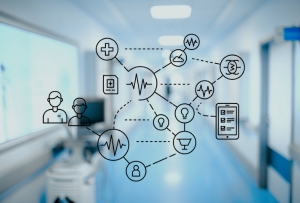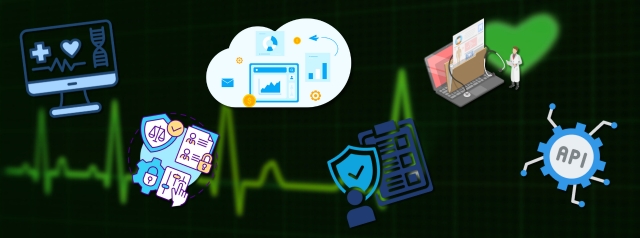When healthcare demands precision and speed, Experion delivers the technology that makes connected care a reality.
In healthcare, timely decisions rely on timely information. But when systems can’t communicate, critical data gets lost in silos. The result? Delays, repeated tests, and missed opportunities to provide better care. That’s why understanding healthcare interoperability is no longer optional. It’s the key to connected, efficient, and patient-centered care.
This article breaks down everything you need to know – from types and benefits to challenges and future trends. If you’re involved in healthcare or health tech, this is the clarity you can’t afford to miss.
What is Healthcare Interoperability?

Healthcare interoperability refers to the ability of various health information systems, applications, and devices to access, exchange, and use medical data in a coordinated and meaningful way. It ensures that critical information follows the patient, whether they’re moving between hospitals, visiting specialists, or using personal health apps, and remains accurate, secure, and actionable throughout their care journey.
Rather than functioning in isolation, modern healthcare ecosystems require a seamless connection between EHRs, imaging systems, lab platforms, pharmacy software, and even wearable health devices. True interoperability makes this possible by creating a digital environment where these systems can speak the same language, interpret data consistently, and support clinical decisions in real time.
The technologies and frameworks that enable this level of communication are often referred to as interoperability solutions. They’re designed not only to move data from one system to another, but also to ensure it’s understood and used effectively at the receiving end, whether by a clinician, a care coordinator, or even the patient.
These solutions make it possible to:
- Share discharge summaries with primary care physicians without delay
- Allow emergency departments to access allergy and medication histories instantly
- Push radiology results directly into a physician’s workflow
- Empower patients to view and manage their own records via mobile apps or portals
Key Components of Effective Healthcare Interoperability Solutions

Creating a truly interoperable healthcare system requires more than just willingness. It demands the right mix of technologies, standards, and governance frameworks that work together to enable accurate and secure data exchange.
Here are the core components that make healthcare interoperability possible:
- Standardized Data Formats: One of the biggest challenges in interoperability is the inconsistency in data formats across different systems. Standards like FHIR (Fast Healthcare Interoperability Resources), HL7 (Health Level Seven), and DICOM (Digital Imaging and Communications in Medicine) provide a common structure for representing health data. These formats ensure that data originating in one system can be correctly interpreted by another, regardless of vendor or platform.
- Application Programming Interfaces (APIs): APIs are the interfaces that allow software applications to talk to each other. In healthcare, APIs enable real-time data sharing between EHRs, mobile health apps, lab systems, and more. For example, a mobile diabetes tracker app can use APIs to pull in real-time blood sugar data and sync it with the patient’s medical record.
- Health Information Exchange (HIE) Platforms: HIE platforms are centralized systems that collect, store, and distribute health data across participating healthcare entities. They are particularly useful in public health programs, regional health networks, and emergency care situations. HIEs support both push and pull models for data sharing and serve as critical hubs for community-wide health information exchange.
- Data Governance and Security Protocols: Interoperability must comply with strict privacy and security regulations, such as HIPAA in the United States. Data governance ensures that data is valid, consistent, and used responsibly. Security protocols include access controls, encryption, audit trails, and patient consent management to protect sensitive health information.
- Cloud-Based Storage and Exchange: Cloud computing brings scalability and flexibility to interoperability. Cloud platforms allow healthcare organizations to store and retrieve large volumes of data quickly and cost-effectively. They also enable real-time collaboration, remote access to records, and disaster recovery capabilities.
- Master Patient Index (MPI): An MPI is a database that maintains a unique identifier for each patient across multiple systems and organizations. It helps ensure that records from different sources are correctly matched to the same individual. Accurate patient matching is critical to prevent mix-ups and maintain data integrity.
Types of Interoperability: Foundational, Structural, and Semantic
Healthcare interoperability is often categorized into three distinct types, each building on the capabilities of the one before it. Understanding these types helps clarify how interoperability functions at different levels.
Foundational Interoperability
This is the most basic level. It allows one information system to send and receive data from another, but without any requirement to interpret the meaning of the data. For instance, a lab system might transmit test results to a hospital’s system, but if the hospital’s software cannot interpret the structure or clinical context of those results, the usefulness remains limited.
Foundational interoperability is a starting point. It gets the data across but doesn’t ensure it’s actionable.
Structural Interoperability
Structural interoperability refers to the standardized format and syntax of the data being exchanged. At this level, systems understand how the data is organized, such as how fields are labeled or how a document is segmented.
This allows the receiving system to display and store data in a structured manner. For example, test results shared in a consistent template make it easier for doctors to scan through and locate relevant metrics.
Structural interoperability makes sure that systems are aligned in how they process and present data, which is crucial for integration and reporting.
Semantic Interoperability
This is the most advanced form. Semantic interoperability ensures that systems understand the meaning of the exchanged data. It uses standardized terminologies, coding systems, and metadata to preserve the clinical intent behind each piece of data.
With semantic interoperability, a diagnosis recorded as “MI” in one system is universally understood as “Myocardial Infarction” across others. Medication names, lab values, and even care plans are interpreted consistently, regardless of the source.
This level of understanding enables true clinical collaboration and meaningful use of shared data.
The Role of Standards (FHIR, HL7, DICOM) in Achieving Interoperability
Standards are the foundation of interoperability. They ensure healthcare systems can exchange data in ways that are structured, understandable, and secure.
FHIR (Fast Healthcare Interoperability Resources)
FHIR is a modern standard developed by HL7. It supports data exchange using web technologies like RESTful APIs, JSON, and XML. Its modular design enables easy sharing of specific data such as patient records or lab results , making it ideal for mobile apps and cloud platforms.
HL7 (Health Level Seven)
HL7 includes widely adopted messaging standards like HL7 v2 and the more structured but less adopted HL7 v3. FHIR was introduced by HL7 as a simpler, modern alternative. HL7 is commonly used to connect hospital systems like billing, labs, and EHRs.
DICOM (Digital Imaging and Communications in Medicine)
DICOM standardizes how medical images (like X-rays and MRIs) are captured, stored, and shared. It ensures consistency in imaging data and metadata, allowing healthcare providers to view and interpret images reliably across different systems.
DICOM (Digital Imaging and Communications in Medicine)
DICOM is the universal standard for managing medical imaging data. It defines how images are captured, stored, transmitted, and displayed, including X-rays, MRIs, CT scans, and ultrasound images.
DICOM not only standardizes the image files but also the metadata attached to them, such as patient identifiers and scan parameters. This ensures that medical images can be viewed and interpreted consistently across different devices and software platforms.
Benefits of Healthcare Interoperability Solutions

The promise of healthcare interoperability solutions extends far beyond data exchange. When implemented effectively, interoperability transforms the entire healthcare experience, benefiting patients, providers, administrators, researchers, and public health systems alike. Let’s explore the major advantages these solutions bring to the healthcare landscape.
Enhanced Patient Safety
At its core, interoperability helps reduce medical errors and enhance clinical decision-making. By giving clinicians access to a patient’s complete and accurate medical history, including past diagnoses, current medications, known allergies, lab results, and imaging, healthcare interoperability solutions minimize the risk of adverse events.
In emergency situations, timely access to such information is often life-saving. Whether it’s avoiding drug interactions or understanding a chronic condition before administering treatment, these solutions ensure that healthcare professionals have the critical context they need when they need it most.
Improved Care Coordination
Many patients receive care from multiple providers like specialists, primary care physicians, labs, and home care teams. Interoperability solutions in healthcare make it easier for all stakeholders to access and contribute to a shared view of the patient’s journey. This leads to smoother transitions between care settings, fewer missed follow-ups, and a collaborative approach to treatment. For instance, when a hospital discharge summary is immediately available to a home nurse or family physician, care becomes continuous and coordinated, not fragmented.
Increased Efficiency and Cost Reduction
Healthcare interoperability is not just about improving care quality. It also brings significant operational and financial benefits. Automated data transfer eliminates the need for redundant paperwork, repeated tests, or administrative delays in processing claims and referrals.
By reducing unnecessary diagnostics, simplifying workflows, and enhancing information flow, interoperability solutions help healthcare organizations save both time and money. These savings can then be redirected toward improving patient services or investing in innovation.
Better Patient Engagement
Modern patients expect to be informed, involved, and empowered in their healthcare decisions. Healthcare interoperability solutions support this expectation by enabling access to personal health records through apps and portals.
Patients can view lab results, track medications, schedule appointments, and even communicate with their care teams. This transparency strengthens trust, improves adherence to treatment plans, and fosters a stronger patient-provider relationship. With data-driven insights, care can also be personalized, making patients feel seen and understood.
Enhanced Research and Population Health Management
One of the most powerful uses of interoperability solutions is in research and population health. By aggregating de-identified health data across regions and institutions, researchers can detect patterns, test hypotheses, and develop better treatment guidelines.
Public health agencies benefit from this data too. Whether tracking vaccination rates, managing chronic diseases, or responding to outbreaks, healthcare interoperability solutions provide the insights necessary for effective policy and intervention.
Key Challenges in Implementing Interoperability Solutions
Despite their clear value, interoperability solutions in healthcare come with their share of challenges. Addressing these obstacles requires strategic planning, investment, and cross-industry collaboration.
Data Privacy and Security Concerns
Perhaps the most sensitive issue in healthcare interoperability is data protection. Medical records contain highly personal and sensitive information. Ensuring that this data is protected from breaches, unauthorized access, or misuse is essential.
Organizations must invest in secure data transfer protocols, robust encryption, identity verification, and role-based access controls. They must also stay in strict compliance with evolving privacy laws and regulations, which vary by region and jurisdiction.
Integration Issues with Legacy Systems
Many healthcare institutions still rely on outdated or proprietary systems that were never designed to communicate with others. These legacy systems may store data in incompatible formats, use non-standard protocols, or lack modern API support.
Integrating these older platforms with new healthcare interoperability solutions can be technically complex and resource-intensive. It often requires custom development, data transformation layers, or even full-scale system upgrades. Moreover, such integrations must be done without disrupting existing workflows or compromising data integrity.
Compliance with Healthcare Regulations (HIPAA, GDPR)
Interoperability solutions must navigate a maze of legal and regulatory requirements. From HIPAA in the United States to GDPR in Europe, healthcare data must be handled with extreme care.
This includes maintaining detailed audit trails, managing patient consent preferences, ensuring secure data storage, and handling cross-border data transfer restrictions. With regulations constantly evolving, staying compliant is a continuous process and one that carries serious consequences if not managed properly.
The challenge grows further when international collaboration is involved. Aligning systems across countries with different legal standards adds another layer of complexity to implementation.
This is where Experion makes a difference with proven expertise in building scalable, standards-driven interoperability frameworks that fit effortlessly into your existing healthcare environment.
Interoperability Solutions in Healthcare

As the industry shifts toward more integrated care delivery models, a wide array of modern interoperability solutions is being developed to address these challenges. These tools are helping healthcare organizations move toward real-time, intelligent, and secure data exchange.
Overview of Modern Interoperability Solutions
Modern healthcare interoperability solutions combine a variety of technologies and frameworks to facilitate data sharing while ensuring accuracy, privacy, and usability.
| Solution |
Description |
| APIs (Application Programming Interfaces) | Tools that allow different healthcare applications to exchange information efficiently, connecting EHRs with apps, labs, billing systems, and wearables. |
| FHIR (Fast Healthcare Interoperability Resources) | A modern standard developed by HL7 using modular resources to represent clinical data; designed for web-based, cross-platform implementation. |
| Health Information Exchange (HIE) | Platforms that support the sharing of patient health information across organizations, vital for aggregating data across regional and national networks. |
| Cloud-Based Storage and Exchange | Provides flexible, scalable infrastructure for storing and accessing health data remotely, enabling real-time collaboration and reducing infrastructure costs. |
| Blockchain Technology | An emerging technology for secure, tamper-proof health data sharing, promoting decentralized record management and improved transparency. |
| Master Patient Index (MPI) | Maintains unique patient identifiers across systems to ensure accurate matching of records from different sources, preserving data integrity and continuity of care. |
Role of Cloud-Based Platforms and APIs
Cloud platforms and APIs are the driving force behind modern interoperability solutions in healthcare. They enable dynamic, real-time data exchange that goes beyond static record sharing.
- Cloud-based Platforms offer centralized storage with flexible access, allowing providers to access up-to-date patient records from any location. They reduce infrastructure costs, improve scalability, and provide built-in redundancy and disaster recovery.
- APIs are essential for real-time data transfer and system integration. For example, when a lab uploads a test result, an API can instantly update the patient’s EHR and notify the care team. APIs are also key to building custom digital health solutions, from mobile apps to telemedicine platforms.
- Security and Updates: Cloud systems typically adopt the latest security measures and are updated regularly. This helps maintain a secure environment for sensitive health information without placing the burden of updates on local IT teams.
By leveraging cloud technologies and APIs, healthcare interoperability solutions become not only more effective but also more accessible to organizations of all sizes.
How to Identify the Right Healthcare Interoperability Solutions
Choosing the right healthcare interoperability solution is a crucial decision that can significantly influence the effectiveness of care delivery, data security, and organizational efficiency. With a growing number of vendors and technologies available, healthcare organizations need a clear framework to evaluate and implement the best-fit solution for their needs.
Factors to Consider When Selecting an Interoperability Solution
Before selecting a solution, healthcare administrators and IT leaders must assess the following criteria to ensure long-term success:
- Compatibility with Existing Systems: The selected solution should integrate seamlessly with your current electronic health record systems, lab platforms, imaging software, and other digital tools without requiring complete system overhauls.
- Scalability for Future Growth: As patient populations grow and data volumes increase, your interoperability solution should be able to scale accordingly. This includes expanding to new facilities or departments without compromising performance.
- Security Features and Compliance: The solution must uphold the highest standards of data protection and meet compliance requirements under regulations like HIPAA and GDPR. Secure access, encryption, audit logging, and consent management are all critical features.
- Ease of Implementation and Integration: Solutions that are easy to deploy and configure minimize disruption during rollout. Smooth integration with existing workflows supports faster adoption and reduces training time.
- Vendor Reputation and Track Record: Opt for vendors with proven success in interoperability solutions in healthcare. Look for customer testimonials, industry certifications, and domain expertise.
- Cost-Effectiveness and ROI: Evaluate the total cost of ownership, including licensing, implementation, training, and maintenance. An effective solution should offer long-term returns through improved care quality, reduced redundancy, and operational efficiency.
- Flexibility and Customization: A good solution allows customization to meet your unique clinical and administrative needs. Look for platforms that can evolve with changing healthcare requirements.
- Data Format Handling: Choose solutions capable of working with a variety of data formats such as HL7, FHIR, and DICOM to ensure maximum compatibility with external systems.
The Importance of Scalability and Compliance
Scalability and compliance are non-negotiables in today’s healthcare environment. A scalable interoperability solution supports the evolution of your healthcare network — whether it’s onboarding more users, adding new locations, or integrating emerging technologies.
Meanwhile, compliance is about much more than just checking boxes. It builds trust with patients, ensures legal protection, and guarantees that sensitive information is handled with the highest standards of confidentiality and integrity. A solution that is both scalable and compliant positions the organization for sustainable growth and long-term success.
Vendor Comparison and Key Solution Providers
To find the right healthcare interoperability solution, healthcare organizations must conduct thorough vendor assessments. This includes:
- Comparing Features: Match product capabilities with your needs. For instance, does the vendor offer FHIR-based API support? Do they enable real-time data exchange?
- Reviewing Pricing Models: Understand licensing costs, subscription fees, and any additional expenses related to training or custom development.
- Checking Customer Reviews: Learn from the experience of other healthcare organizations. User feedback offers insights into usability, vendor support, and system performance.
- Evaluating Industry Experience: Look for vendors who specialize in healthcare and have experience with hospitals, clinics, or health information exchanges.
- Seeking Comprehensive Support: The best vendors provide end-to-end support — from implementation to ongoing system maintenance and staff training.
How Experion Can Offer Support With Healthcare Interoperability Solutions

At Experion, we understand the complex challenges healthcare organizations face in achieving true interoperability. Our deep expertise in product engineering, paired with a domain-first approach, allows us to deliver interoperability solutions that are secure, scalable, and purpose-built for healthcare.
Expert Consulting and Strategy
We start by assessing your current digital ecosystem to identify gaps in interoperability. Our consulting team works closely with your stakeholders to:
- Map out your existing workflows and data flows.
- Pinpoint inefficiencies and areas for improvement.
- Design a tailored strategy that aligns with your operational goals.
- Recommend the right tools and technologies for your specific requirements.
Implementation and Integration Services
Experion’s technical teams are skilled in system integration using industry standards like HL7 and FHIR. Our services include:
- Custom development of APIs to enable seamless communication across systems.
- Integration of EHRs, lab systems, and third-party health platforms.
- Development of cloud-based health information exchanges.
- Ensuring consistent, real-time data availability across the care continuum.
Data Management and Security
Security and compliance are foundational in every solution we build. We help you:
- Implement robust data protection frameworks with encryption, access controls, and audit logs.
- Stay compliant with international standards such as HIPAA, GDPR, and regional regulations.
- Establish data governance practices that ensure accuracy and accountability.
Ongoing Support and Maintenance
We believe in long-term partnerships. Our support services ensure that your healthcare interoperability solution continues to perform optimally:
- Continuous system monitoring and proactive issue resolution.
- Regular updates and compatibility checks with evolving standards.
- User training programs to onboard clinical and administrative staff with confidence.
By choosing Experion, you are investing in a solution that prioritizes patient care, supports compliance, and delivers measurable results.
Future Trends in Healthcare Interoperability
As the healthcare industry continues its digital transformation, interoperability is evolving beyond basic connectivity. New technologies and policy shifts are shaping the next phase of interoperability solutions in healthcare.
The Role of AI and Machine Learning in Data Exchange
Artificial intelligence is expected to play a pivotal role in enhancing healthcare interoperability:
- AI-Powered Data Mapping: Machine learning algorithms can map data fields across disparate systems, helping resolve inconsistencies in real-time.
- Predictive Analytics for Interoperability: AI tools can identify potential gaps in data exchange, alerting providers before they impact patient care.
- Intelligent Automation: Routine data exchange processes — such as data validation, record matching, and workflow synchronization — can be automated, reducing human error and increasing speed.
- AI-Driven Patient Outcomes: By analyzing large volumes of integrated health data, AI can support personalized treatment plans and early detection of medical issues.
Blockchain for Secure and Transparent Healthcare Data Sharing
Blockchain is emerging as a game-changing technology for secure, decentralized health data exchange:
- Decentralized Storage: Patient data can be stored across distributed networks, reducing reliance on central databases and improving redundancy.
- Enhanced Audit Trails: Blockchain records every data access or change in an immutable ledger, ensuring full traceability.
- Improved Patient Control: Patients can grant or revoke access to their data through smart contracts, giving them more control over their privacy.
- Secure Interprovider Communication: Blockchain facilitates trustless transactions between healthcare organizations, promoting transparent collaboration.
Government Initiatives and Policy Updates Supporting Interoperability
Governments around the world are taking active steps to drive the adoption of healthcare interoperability solutions:
- Increased Regulatory Emphasis: Policies now encourage or mandate data sharing between healthcare systems, with a focus on patient rights and transparency.
- Standardization Programs: Agencies are investing in national frameworks that define how data should be structured, transmitted, and secured.
- Funding and Incentives: Many governments are offering grants or reimbursement programs to support healthcare providers in implementing interoperable technologies.
- Cross-Border Collaboration: Initiatives are being developed to enable safe data exchange between countries, especially in response to global health emergencies.
Conclusion
At its core, healthcare interoperability is about connection – connecting systems, data, care teams, and most importantly, patients. It transforms fragmented processes into a cohesive ecosystem where information flows freely, securely, and meaningfully.
Choosing the right healthcare interoperability solution is not merely a technical step, but a strategic move toward improving care quality, operational efficiency, and patient trust. It empowers healthcare providers to act faster, collaborate better, and deliver care that’s not only informed but also personalized.
As a trusted healthcare technology partner, Experion delivers more than just solutions; we transform.
Let’s build systems that not only communicate but create lasting value across your care network!

